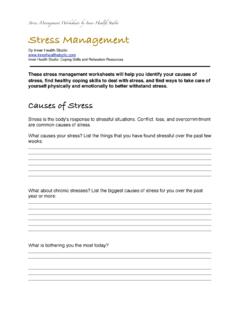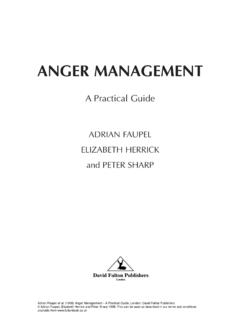Transcription of 04-1 Anger Worksheet Naming Anger Types and …
1 Anger Management Worksheet 4-1: Naming Types and Variations of Anger (Skill 4). This Worksheet increases your awareness by pinpointing the exact type or variation of your Anger in 2 ways: what you felt then (in the situation) and what you feel now while you are thinking about and remembering the situation. Steps 1: Circle the words below that accurately complete the following sentence for you. Blank lines are provided for writing in words not in the list. During the situation that I am remembering, the words that best describe my Anger are: Annoyed Antagonized Betrayed Enraged Irritated Affronted Disgusted Furious Frustrated Resentful Incensed Seething Miffed Galled Exasperated Infuriated Provoked Pissed Steamed Violent Pestered Insulted Outraged Explosive Stung Harassed Pissed off _____.
2 _____ _____ _____ _____. Step 2: Now put a star by the words for what you feel now, in this moment, while you are remembering. Anger Management Worksheets Copyright 2012 Gregory E. Hamlin Page 1. Anger Management Worksheet 4-1: Naming Types and Variations of Anger (Skill 4). Worksheet Skills and Concepts Continuing the series of Anger management worksheets, we now turn to pinpointing the Types of Anger you experience and we compare two moments in time. The two steps for completing this Worksheet correspond to the twin goals of this exercise. In steps 1 the goal is to think about different Types of Anger . There is a certain amount of control that we gain just by Naming something. This because identifying something more specifically helps us to know it better.
3 If you have to tame an elephant, you will probably do better if you know the difference between an African Elephant and an Indian Elephant. Like elephants, Anger comes in variations. The techniques we use to control one type of Anger are not always effective for another variation. For example, if you are annoyed by what someone is saying, it might be best to ask more clarifying questions and try to hold yourself together while you are listening. If, on the other hand, you are ready to explode, controlling your Anger may mean excusing yourself from the situation altogether so that you can cool down. Step 1: What I Felt Then Take 60 seconds to remember the situation in detail. In your mind, step through the sequence of what happened. What feelings of Anger did you feel during the situation?
4 This may or may not be similar to how you feel right now. For example, you might feel calm while you are completing the Worksheet , but you remember how you felt at the time the situation was unfolding. Step 1 is about looking at your Anger in history, not the present. Anger Management Worksheets Copyright 2012 Gregory E. Hamlin Page 2. Anger Management Worksheet 4-1: Naming Types and Variations of Anger (Skill 4). Step 2: What I Feel Now (While Thinking About the Past). Now, we switch gears. Take 30 seconds to remember the situation again in detail. For a second time, use your imagination to step through the sequence of what happened. Now, as you think about the situation, observe what feelings you are experiencing NOW, while you are remembering. Now you put a star by the words that best describe the Anger that comes up while you are thinking about it.
5 Are you feeling any feelings of Anger similar to the words you checked? If so, this is called re-experiencing because you are reliving an angry situation on an emotional level. Aim for These Emotional Intelligence Skills In this Worksheet , aim for developing these emotional intelligence skills. To actually begin to develop these skills, the Worksheet must be used several times following numerous, different situations in which you became angry. 1. Selecting a situation of Anger . Admitting to yourself that you were, in fact, angry at the time. 2. Learn to be more specific about your emotions by pinpointing a specific type of Anger . A car is not a truck and rage is not irritation. Learn to be honest with yourself. Don't exaggerate, but don't minimize.
6 3. Distinguish between feelings THEN vs. NOW. 4. Learn to recognize RE-EXPERIENCING as a real part of your experience of Anger . Anger Management Worksheets Copyright 2012 Gregory E. Hamlin Page 3.






